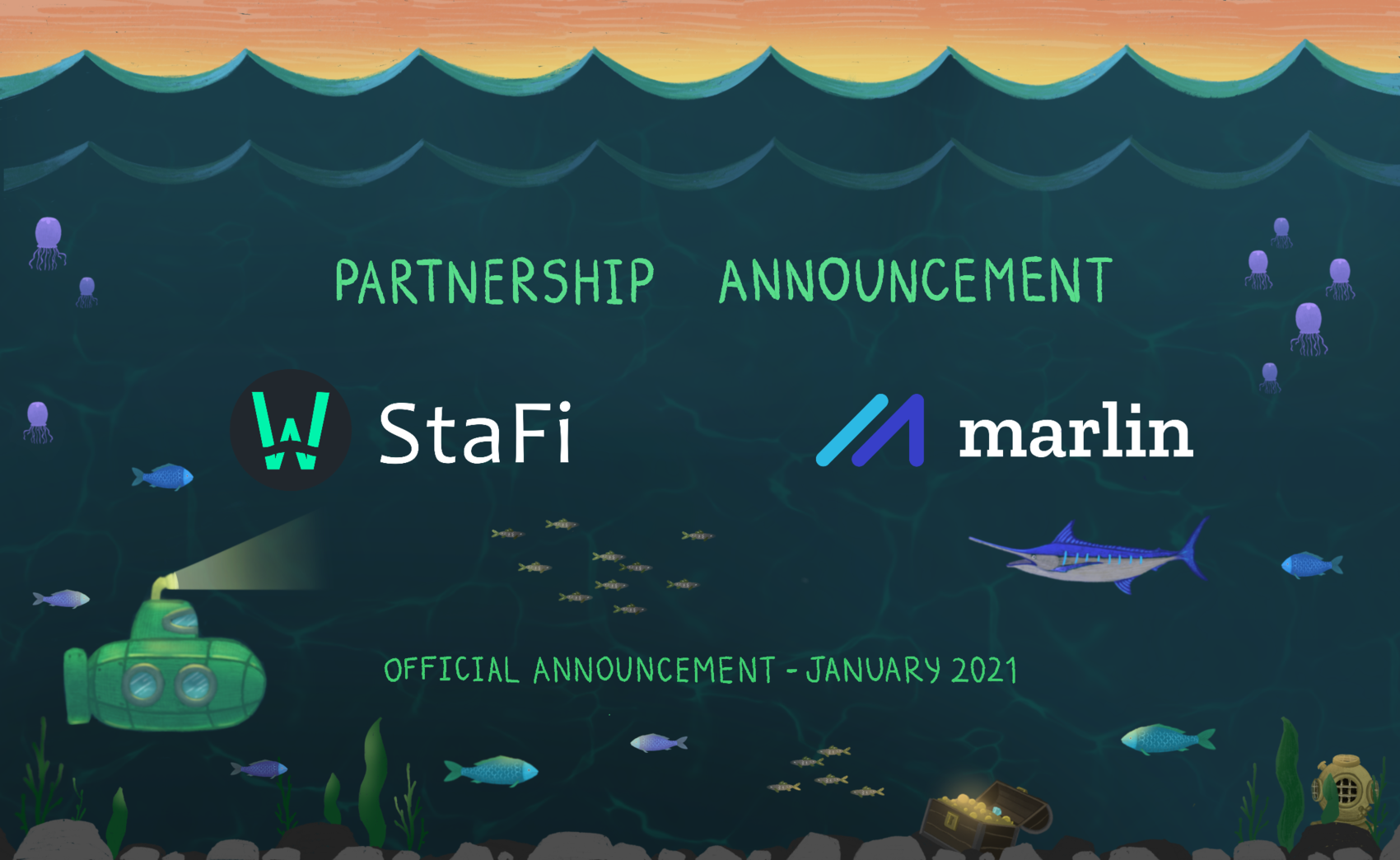Marlin Biweekly 2 Dev & Community Updates – February 2022
Here are the latest developments for the second half of February!
Here are the latest developments for the second half of

We’re elated to announce that StaFi will be closely collaborating with Marlin in integrating its layer-0 scaling protocol and creating liquid staking derivatives of its network token POND.
Liquid staking
Proof-of-stake based chains require validators to lock native protocol tokens as stake to guarantee security against double signing and similar malicious attacks on blockchains. Staked tokens are non-tradeable and reduce the liquidity of the token owner until the token is unbonded from staking which carries a further unbonding period. Moreover, staking is sometimes a compulsion rather than a choice for token holders as they get paid a portion of the network’s fees and rewards against their stake failing which their percentage share in the system reduces thanks to inflation.
StaFi solves this issue by creating a wrapper contract around the staking contract. It allows token holders to deposit tokens to this wrapper which proxies them to the native staking contract providing the user a rToken in return. In this way, the user gets to stake his token and receive a proportionate share of fees and rewards while also having a tradeable representation of the share providing liquidity and the freedom to trade if and when required.
Layer-0 scaling
Since many staking protocols are based on different blockchains and not just Ethereum, StaFi uses Polkadot as an interoperability solution to communicate between chains. Consequently, StaFi has built out its own chain based on the popular Substrate framework. Having one’s chain has its own pros and cons, a major one being the ever-pressing scalability trilemma: choosing between security, decentralization and scaling.
A block producer in StaFi generates a block every six seconds which has to be propagated amongst a validator set of 140 nodes within the block interval. It is known from the widely popular scaling debates that large network sizes, large blocks and short block times don’t go hand in hand. As a liquid staking protocol, security is paramount to StaFi. A compromised liquid staking protocol could compromise the security of several chains as well as the interests of its token holders. Thus, increasing the number of nodes is important to the StaFi network.
Simultaneously, StaFi is also required to keep up with increasing volumes and performance expectations as it integrates with numerous new chains with varying choices of parameters. Marlin provides a network layer scaling protocol that can be easily integrated with blockchains such as StaFi allowing a larger validator network without limiting block times. Being a layer-0 protocol, performance improvements with Marlin do not have security or decentralization costs as the base peer-to-peer layer itself is enhanced instead of making application layer tradeoffs.
Our collaboration
The teams at StaFi and Marlin have been working together for a while and this announcement only crystallizes an ongoing collaboration. In the coming days, users of both projects can expect the following developments:
(i) Marlin relay and gateway nodes for StaFi validators to utilize the Marlin network
“Marlin relays would allow StaFi nodes to propagate larger blocks and hear about them faster all without limiting validator set size. This would increase the security of the system overall by reducing the likelihood of nodes not hearing about blocks due to network partitions or otherwise. We look forward to the release of Marlin gateways and staking network along with the launch of rPOND.”
-Liam, CEO of StaFi
(ii) Release of rPOND to provide liquid staking opportunities for Marlin token holders
“Since staking in Marlin is going to launch with an unbonding period of 30 days while providing highly competitive rewards to validators, our work with StaFi to develop rPOND should be of great interest to POND token holders planning to participate in the network. StaFi’s new Ethereum bridge makes rPOND nearly indistinguishable from POND itself.”
-Siddhartha, CEO of Marlin
Glimpse into Polkadot and Substrate communities
StaFi is at the cutting edge of a growing Polkadot DeFi ecosystem. It presents an exciting opportunity for Marlin to work with Substrate-based projects and examine any peculiarities in further detail. Over the course of coming months, we anticipate developing integrations with several other Substrate projects and are pleased to have begun this journey with the experienced developers at StaFi .
About StaFi
StaFi is the first DeFi protocol unlocking liquidity of staked assets. Users can stake PoS tokens through StaFi and receive rTokens in return, which are available for trading, while still earning staking rewards. FIS is the native token on StaFi Chain. FIS is required to provide security to the network by staking, pay for transaction fees on the StaFi chain, and mint & redeem rTokens.
About Marlin
Marlin is an open protocol that provides a high-performance programmable network infrastructure for DeFi and Web 3.0. Marlin aims to deliver on the promise of a decentralized web where applications secured via the blockchain are indistinguishable in terms of performance to users accustomed to Web 2.0. Marlin is backed by a prominent group of stakeholders including Electric Capital, Michael Arrington, DHVC, Fenbushi and the leading cryptocurrency exchange, Binance.
Follow us on our official channels to stay up to date on all things Marlin!
Twitter | Telegram Announcements | Telegram Chat | Discord | Website
Subscribe to our newsletter.